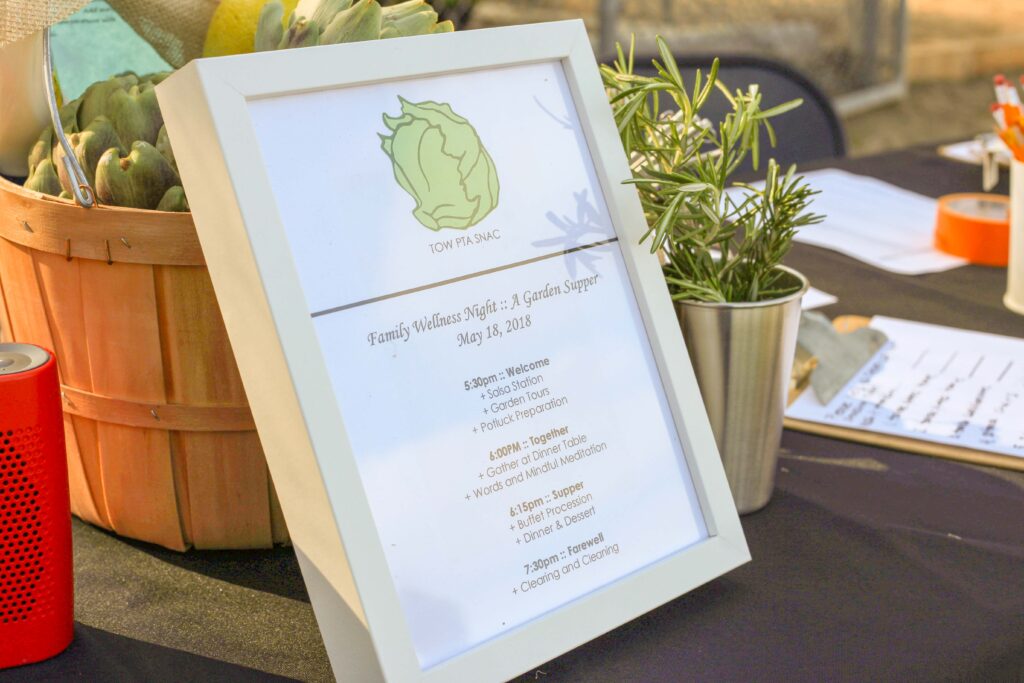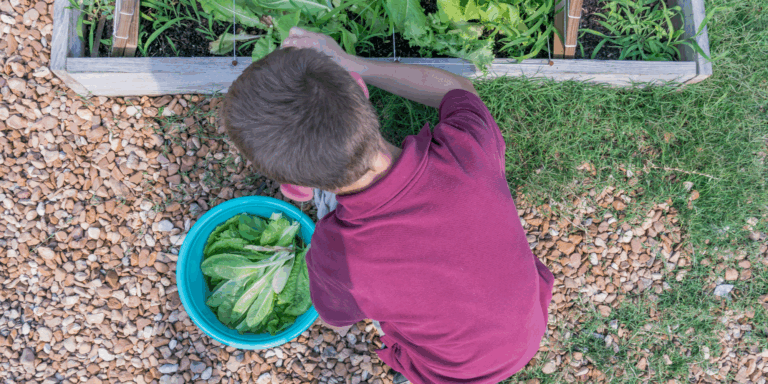Cultivating Healthy Schools: A Parent Guide
How one California parent activated a school to celebrate nourishing meals.
Join our corps! Applications for 2026-2027 are now open. Apply by March 30.
How one California parent activated a school to celebrate nourishing meals.

When my kids were little, they attended a preschool that scratch-cooked whole-food meals and snacks for the entire school, using many ingredients from the school garden. All the children ate the same meal. You know what that meant? They happily ate what was on their plate, together.
When my kids started elementary school, we enrolled them in our local public school in Orange County, California. The lunches couldn’t have been more different—and because of that, we opted to pack lunches daily. But I knew that some students needed those school lunches, whether it was because this was a daily, secure meal they could get for free or a reduced price, or because parents and caregivers managing a busy home life needed the convenience of school lunch. Having seen that scratch cooking school lunches was possible, I decided to channel my parent advocacy to rev up the school lunch conversation in our district.
I thought the best way to approach this was to lean into the idea that we all want the best for our kids. Why shouldn’t that include school lunches? If we put food on students’ plates, then shouldn’t we make sure it’s the best it can be? These are the questions I shared with my fellow PTA parent volunteers. They were fired up and quickly approved $500 in the PTA budget to see what I could do.
Enter SNAC, or Student Nutrition Advisory Committee—a grassroots initiative that helped transform school nutrition in our district, and one that I hope can serve as inspiration for other communities. How did we do it, and more importantly, how can you replicate this success in your schools and communities? Let’s break it down step by step.
Every great initiative starts with a spark—an idea that ignites passion and drives change. For us, it was the simple notion of harnessing the power of community to cultivate conversation, which morphed into action that ultimately meant healthier habits among our children.
We started by gathering a group of like-minded parents, teachers, and community members who shared our vision for better nutrition in schools. I also made it my mission to get educated. One place I started was by attending the California Farm to School Conference, learning about the ecosystem, resources, and best practices, not to mention meeting some incredible advocates in the space.
With the brain-trust of our parents and community members, we built a one-page mandate for SNAC that listed three areas of focus that included both in- and out-of-school initiatives driven by parent volunteers: Education Activities (recipe sharing and tastings), Outreach Activities (SNAC tables featuring a “Harvest of the Month”), and Environmental Action Projects (“Meatless Mondays,” cultivating our school garden, etc.).

But our pinnacle event was to be a community-wide Wellness Dinner, as a way to show that scratch cooking didn’t have to be fancy or complicated to be tasty and nutritious, and that slowing down to share a community meal benefited our health and well-being in a myriad of ways.
Getting buy-in from school and district officials was a crucial step in our journey. We presented SNAC as a collaborative effort to improve the health and well-being of our children. I involved our school principal in the discussions early and got his guidance on how best to include the administration. I requested a meeting with our Assistant Superintendent of Business Services to understand the costs and logistics the district faced in feeding our students.
I also toured our school kitchens with our District Nutrition Services Director to learn about the federal and state regulations that she needed to adhere to, and to assure her we wanted to work collaboratively and activate her expertise. By showcasing the positive and inclusive impact of our initiative, we were able to garner support from key stakeholders.
They say there’s strength in numbers, and that couldn’t be truer when it comes to effecting change. Once we had our core group of advocates, we found more ways to leverage the talent of our community —nutritionists, chefs, yoga teachers, avid hobby gardeners, people who believed in our mission. The more voices we had at the table, the stronger our foundation, and therefore our movement, became.
Creating a physical space where families could come together to learn and grow was essential to the success of SNAC. Fortunately, we were able to utilize our school garden as the backdrop for our wellness activities. If you don’t have a garden, don’t worry—think outside the box and explore other community spaces that may serve your needs.

The heart of SNAC—the Wellness Dinners. These gatherings are a perfect blend of education, engagement, and, of course, delicious food. Each spring, we organized a community-wide potluck dinner on the lawn just outside our school garden, using recipes inspired by TheLunchBox.org and Chef Ann Cooper’s work. (The Chef Ann Foundation offers grants to schools who want to move to scratch cooking—check it out!)
We curated menus that highlighted our garden’s seasonal ingredients and set up long dinner tables with sustainable dinnerware for a community gathering. Each dinner brought together about 120 parents and students and, given the overwhelming response, the PTA increased our budget from $500 to $1500 to help offset the costs of the dinner. This included renting tables and chairs, purchasing flowers for simple centerpieces, reusable dinnerware, and printing paper menus and activity sheets.
Each family attending was assigned a side dish or dessert—a contribution of both time and money, as families paid for the ingredients—and the PTA catered the main dish. Families were emailed recipe cards and asked to prepare their contributions at home. Once they arrived at the garden, all the “sides” families emptied their containers into large chafing dishes and volunteers tossed and mixed. (The collective sum forgave the occasional over- or under-salting.) “Dessert” families curated a gorgeous picnic table spread of their fruit-forward offerings.
While volunteers prepared the potluck stations, parents and children got to walk through the garden in a scavenger hunt looking for herbs, fruit trees, and vegetables. The students were proud to show their parents what they knew from garden classes. These classes were initially seeded by a PTA stipend for an outdoor classroom initiative taught during the school day. Because it was a family night, we had plenty of simple cooking activities to do—like making salsa in the garden and providing mini mason jars so families could take their creations home.
Once we settled in for dinner, our local yoga teacher began the dinner with a simple mindfulness exercise. She asked us to close our eyes and smell the sprigs of lavender that we laid on the tables. It gave us all a moment to slow down together and become present for the lovely meal we all built.
The children ate joyfully: things like Southwest Quinoa Salad, Cilantro-Lime Roasted Cauliflower, and Indian Coconut Hummus. When the parents continued to gather and talk after the meal, the children ran through the schoolyard, playing and laughing. From hands-on gardening activities to wellness projects, the annual dinners were a memorable experience for families.
The work that SNAC did helped to reignite our district’s commitment to slow modifications to the school lunch menu, including more scratch cooking, empowering the kitchen staff to learn new skills, and coordinating with the school gardens to use garden ingredients when possible. With buy-in from key district stakeholders, and as they saw how important it was to the community, they invested dollars in making these changes.
SNAC serves as a testament to the transformative power of grassroots initiatives and the authentic dedication of passionate parents, community members, and other individuals. By following these steps and adapting them to your own unique circumstances, you can cultivate healthier communities and empower our children to thrive. Together, let’s sow the seeds of change and watch as they blossom into a brighter, healthier future for all.
Shaheen Sheik-Sadhal is a lawyer, writer, mother, and two-time PTA President based in Southern California.

Our 2025 Child Nutrition Policy Year in Review

Winterizing Your School Garden

5 Awesome Small Businesses by FoodCorps Alums